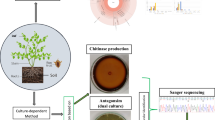Summary
Studies on the survival ofPseudomonas solanacearum, the causal agent of bacterial wilt of tomato, under laboratory conditions showed that soil amendments had little effect on the population of the pathogen. When the host plant was grown in amended soil there was a positive influence on growth of the pathogen. The population level of the pathogen incorporated into the soil was reduced to one-half within a period of 46 days.
The pathogen survived in the rhizosphere of non-host plants belonging to the families Acanthaceae and Leguminosae even in the absence of the natural hosts, but its incidence in the rhizosphere of plants belonging to Graminae and Cyperaceae was comparatively low indicating possibilities of reducing the inoculum potential of the pathogen in tomato fields by allowing such plants to grow during fallow periods.
Similar content being viewed by others
References
Anonymous 1966 Laboratory Methods in Microbiology. Eds. W. F. Harrigan and M. E. Ma Canca, Academic Press, London 324 p.
Dukes, P. D., Jenkins, J. S. F., Jaworki, C. A. and Morton, D. J. 1965 The identification and persistence of an indigenous race ofPseudomonas solanacearum in a soil in Georgia. Plant. Dis. Rep.49, 586–590.
Hoskins, W. M. 1961 Mathematical treatment of loss of pesticide residues. Plant Prot. Bull. FAO9, 163–188.
Karganilla, A. P. and Buddenhagen, I. W. 1972 Development of selective medium forPseudomonas solanacearum. Phytopathology62, 1373–1376.
Kelman, A. 1953 The bacterial wilt caused byPseudomonas solanacearum. N.C. Agric. Exp. Stn. Tech. Bull.99, 194.
King, H. del and Wallace, R. H. 1956 Morphological and physiological groups of soil bacteria from the roots of barley and oats. Can. J. Microbiol.2, 473–481.
Krassinilkov, N. A. 1944 Microflora of soils as influenced by plants. Mikrobiologia USSR3, 348–358.
Leben, C. 1973 Survival of plant pathogenic bacteria. Abstr. 0326. 2nd Int. Congr. Plant Pathol. Minneapolis.
Lochhead, A. G. 1940 Qualitative studies on soil microorganisms. III. Influence of plant growth on the character of the bacterial flora. Can. J. Res. C.18, 42–53.
Lochhead, A. G. and Thaxton, R. H. 1953 Qualitative studies on soil microorganisms. X. Bacteria requiring vitamin B12 as growth factor. J. Bacteriol.63, 219.
Martin, J. P. 1950 Use of acid, rose bengal and streptomycin in the plate method of estimating soil fungi. Soil Sci.69, 215.
McCarter, S. M. 1976 Persistence ofPseudomonas solanacearum in artificially infested soils. Phytopathology66, 998–1000.
McCarter, S. M., Dukes, P. D. and Jaworski, C. A. 1969 Vertical distribution ofPseudomonas solanacearum in several soils. Phytopathology59, 1675–1677.
Nakata, K. 1927 Concerning the vitality and pathogenicity ofBacterium solanacearum (E.F.S.) a cause of tobacco wilt. J. Sci. Agric. Soc. Japan296, 283–304.
Rangaswami, G. and Rangarajan, M. 1966 Studies on the survival of plant pathogens added to the soil. IV.Xanthomonas musicola. Indian Phytopathol.19, 294–297.
Rangaswami, G. and Vasantharajan 1961 Studies on the rhizosphere microflora of citrus plants as influenced by streptomycin spray. Curr. Sci.30, 25–26.
Rouatt, J. W. 1959 Initiation of the rhizosphere effect. Can. J. Microbiol.5, 67–71.
Rovira, A. D. 1956 A study on the development of root surface microflora during the initial stages of plant growth. J. Appl. Bacteriol.19, 72–79.
Schuster, M. L. and Coyne, D. P. 1974 Survival mechanisms of phytopathogenic bacteria. Annu. Rev. Phytopathol.12, 199–216.
Timonin, M. I. 1940 The interaction of higher plants and soil microorganisms. I. Microbial population of rhizosphere of seedlings of certain cultivated plants. Can. J. Res. C18, 307–317.
Author information
Authors and Affiliations
Additional information
Part of the thesis of the Senior Author presented to the Kerala Agricultural University, Trichur, Kerala State, India.
Rights and permissions
About this article
Cite this article
Devi, L.R., Ramanatha Menon, M. & Aiyer, R.S. Survival ofPseudomonas solanacearum in soil. Plant Soil 62, 169–182 (1981). https://doi.org/10.1007/BF02374082
Received:
Revised:
Issue Date:
DOI: https://doi.org/10.1007/BF02374082




